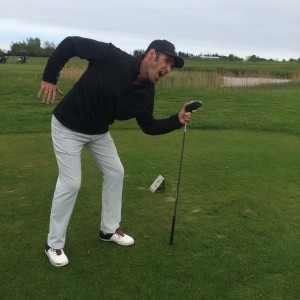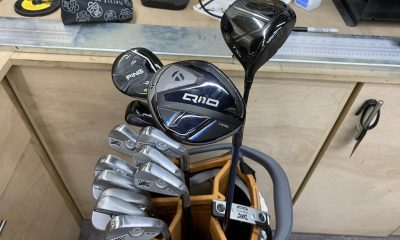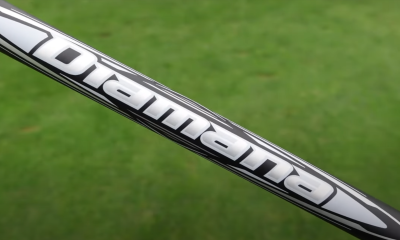Improve your hip movement so you can swing and feel better
“If you have a body then you are an athlete!” – Bill Bowerman
I love this quote from Bill Bowerman, a track-and-field coach who was a co-founder of Nike, because of its simplicity. It’s a reminder to golfers that no matter their shape, weight, age or golfing ability, they are without a doubt an athlete.
If we agree that everyone is an athlete, it makes sense that to improve athletic performance, golfers need to do what they can to remove physical limitations from their game. The good news is that the simplest of activities that you do on a daily basis are athletic movements. Everything from getting up in the morning, to making a cup of coffee, drinking the coffee to sitting on the toilet are all athletic movements and require functional movement. To perform them, your body needs to work together as a unit in order to function efficiently on a daily basis. Your brain needs to communicate to your central nervous system, which in turn needs to communicate to the correct muscles and activate them in the correct firing sequence to achieve the task at hand. So in this sense, movement is athleticism. The more complicated the task, the more athletic ability is required; the less complicated the task, the less athletic ability is required. This is what Bowerman meant when he said, “If you have a body then you are an athlete.”
The golf swing is a complicated athletic movement that demands a whole lot from your body every time you set up to the ball and swing the club. It’s powerful, explosive and you will need a descent amount of athletic ability to make an efficient golf swing. So it all comes down to you as an individual, and how athletically your body can or can’t move that will determine how efficiently you can make a golf swing.
Here’s the Kicker
It never ceases to amaze me how many people go around with physical limitations on a daily basis, and are completely unaware that they have these hidden problems that prevent them from moving more athletically. Unfortunately, having limitations forces golfers to compensate from moving athletically and functionally.  Not only do they lead to poor ball striking, but usually at some point down the road pop up in the form of an injury due to overworked muscles compensating for faulty movement patterns. More often than not, injuries occur not where the limitations are, but in the joints that are placed above or below the dysfunctional area.
Not only do they lead to poor ball striking, but usually at some point down the road pop up in the form of an injury due to overworked muscles compensating for faulty movement patterns. More often than not, injuries occur not where the limitations are, but in the joints that are placed above or below the dysfunctional area.
Take the lower back, for example. It’s one of the more common areas that plague golfers with pain, and believe me, this has nothing to do with your age either. Statistics say that 80 percent of people in their 20’s have suffered from lower back pain. One of the culprits for lower back pain is lack of hip mobility. In the golf swing, if your hips aren’t able to turn efficiently, then you will be forced to compensate in your swing. It puts a ton of added stress on the joints that are both above the hips, the lower back, or below the hips, the knees.
So it’s up to you. If you want a more efficient golf swing that can produce penetrating drives straight down the middle of the fairway and past your playing partners ball, or you’d just like to remove that nagging slice while at the same time have no more pain, why not start by overhauling your body so that it can move more athletically?
Here’s How
First of all, you’ll need to take a physical assessment, and by this I DO NOT mean you’ll need to bend over and cough twice!
PHHEEW…. No, I mean you’ll need to visit a golf Medical or Fitness expert, you can find one here. They can make a simple physical assessment of you to check and see how well your joints and muscles can move. If you have any limitations, then they’ll give you some simple exercises that can help get you straightened out and on the right path to improving your golf performance and your quality of life as an added bonus.
Watch this video as I walk you through some exercises and tests that will get your hips moving efficiently so that you can make a more athletic movement in your golf swing. Also, I’ve added a test with correctional exercises directly from my book Golfers Handbook – Save your golf game and your LIFE below that you can try at home.
- LIKE60
- LEGIT10
- WOW4
- LOL0
- IDHT0
- FLOP1
- OB1
- SHANK31
Instruction
Clement: Laid-off or perfect fade? Across-the-line or perfect draw?

Some call the image on the left laid off, but if you are hitting a fade, this could be a perfect backswing for it! Same for across the line for a draw! Stop racking your brain with perceived mistakes and simply match backswing to shot shape!
- LIKE0
- LEGIT0
- WOW0
- LOL0
- IDHT0
- FLOP0
- OB0
- SHANK1
Instruction
The Wedge Guy: The easiest-to-learn golf basic

My golf learning began with this simple fact – if you don’t have a fundamentally sound hold on the golf club, it is practically impossible for your body to execute a fundamentally sound golf swing. I’m still a big believer that the golf swing is much easier to execute if you begin with the proper hold on the club.
As you might imagine, I come into contact with hundreds of golfers of all skill levels. And it is very rare to see a good player with a bad hold on the golf club. There are some exceptions, for sure, but they are very few and very far between, and they typically have beat so many balls with their poor grip that they’ve found a way to work around it.
The reality of biophysics is that the body moves only in certain ways – and the particulars of the way you hold the golf club can totally prevent a sound swing motion that allows the club to release properly through the impact zone. The wonderful thing is that anyone can learn how to put a fundamentally sound hold on the golf club, and you can practice it anywhere your hands are not otherwise engaged, like watching TV or just sitting and relaxing.
Whether you prefer an overlap, interlock or full-finger (not baseball!) grip on the club, the same fundamentals apply. Here are the major grip faults I see most often, in the order of the frequency:
Mis-aligned hands
By this I mean that the palms of the two hands are not parallel to each other. Too many golfers have a weak left hand and strong right, or vice versa. The easiest way to learn how to hold the club with your palms aligned properly is to grip a plain wooden ruler or yardstick. It forces the hands to align properly and shows you how that feels. If you grip and re-grip a yardstick several times, then grip a club, you’ll see that the learning curve is almost immediate.
The position of the grip in the upper/left hand
I also observe many golfers who have the butt of the grip too far into the heel pad of the upper hand (the left hand for right-handed players). It’s amazing how much easier it is to release the club through the ball if even 1/4-1/2″ of the butt is beyond the left heel pad. Try this yourself to see what I mean. Swing the club freely with just your left hand and notice the difference in its release from when you hold it at the end of the grip, versus gripping down even a half inch.
To help you really understand how this works, go to the range and hit shots with your five-iron gripped down a full inch to make the club the same length as your seven-iron. You will probably see an amazing shot shape difference, and likely not see as much distance loss as you would expect.
Too much lower (right) hand on the club
It seems like almost all golfers of 8-10 handicap or higher have the club too far into the palm of the lower hand, because that feels “good” if you are trying to control the path of the clubhead to the ball. But the golf swing is not an effort to hit at the ball – it is a swing of the club. The proper hold on the club has the grip underneath the pad at the base of the fingers. This will likely feel “weak” to you — like you cannot control the club like that. EXACTLY. You should not be trying to control the club with your lower/master hand.
Gripping too tightly
Nearly all golfers hold the club too tightly, which tenses up the forearms and prevents a proper release of the club through impact. In order for the club to move back and through properly, you must feel that the club is controlled by the last three fingers of the upper hand, and the middle two fingers of the lower hand. If you engage your thumbs and forefingers in “holding” the club, the result will almost always be a grip that is too tight. Try this for yourself. Hold the club in your upper hand only, and squeeze firmly with just the last three fingers, with the forefinger and thumb off the club entirely. You have good control, but your forearms are not tense. Then begin to squeeze down with your thumb and forefinger and observe the tensing of the entire forearm. This is the way we are made, so the key to preventing tenseness in the arms is to hold the club very lightly with the “pinchers” — the thumbs and forefingers.
So, those are what I believe are the four fundamentals of a good grip. Anyone can learn them in their home or office very quickly. There is no easier way to improve your ball striking consistency and add distance than giving more attention to the way you hold the golf club.
More from the Wedge Guy
- The Wedge Guy: Golf mastery begins with your wedge game
- The Wedge Guy: Why golf is 20 times harder than brain surgery
- The Wedge Guy: Musings on the golf ball rollback
- LIKE88
- LEGIT15
- WOW6
- LOL1
- IDHT0
- FLOP4
- OB1
- SHANK8
Instruction
Clement: Stop ripping off your swing with this drill!

Not the dreaded headcover under the armpit drill! As if your body is defective and can’t function by itself! Have you seen how incredible the human machine is with all the incredible feats of agility all kinds of athletes are accomplishing? You think your body is so defective (the good Lord is laughing his head off at you) that it needs a headcover tucked under the armpit so you can swing like T-Rex?
- LIKE0
- LEGIT3
- WOW2
- LOL0
- IDHT0
- FLOP0
- OB0
- SHANK2
-

 19th Hole3 weeks ago
19th Hole3 weeks agoJustin Thomas on the equipment choice of Scottie Scheffler that he thinks is ‘weird’
-

 19th Hole3 weeks ago
19th Hole3 weeks ago‘Absolutely crazy’ – Major champ lays into Patrick Cantlay over his decision on final hole of RBC Heritage
-

 19th Hole2 weeks ago
19th Hole2 weeks agoLET pro gives detailed financial breakdown of first week on tour…and the net result may shock you
-

 19th Hole3 days ago
19th Hole3 days agoReport: LIV star turns down PGA Championship invite due to ‘personal commitments’
-

 19th Hole1 week ago
19th Hole1 week agoGary Player claims this is what ‘completely ruined’ Tiger Woods’ career
-

 Whats in the Bag2 weeks ago
Whats in the Bag2 weeks agoTeam McIlowry (Rory McIlroy, Shane Lowry) winning WITBs: 2024 Zurich Classic
-

 19th Hole3 weeks ago
19th Hole3 weeks agoTaylorMade signs 15-year-old AJGA Rolex Junior Player of the Year to an NIL contract
-

 Equipment1 week ago
Equipment1 week agoGolf fans left surprised by LIV’s choice of course for its 2024 individual championship event












Randy
Jun 5, 2016 at 12:34 pm
The video link in the last paragraph is still set to private.
Golfshapeforelife
Jun 3, 2016 at 8:12 am
Good exercise. I have coached Track & Field (We call it Athletics here in the UK), and have been a Sprinter/Jumper myself and find that simple walkover/stepover drills over low-level barriers (such as two upturned range ball buckets with a shaft laid across) work fine. Anyone can do a fire hydrant and a few trail leg drills, these open up the hips very well
Adam Stevenson
Jun 3, 2016 at 9:02 am
Golfshapeforelife, thank you for your response. You’re right, walkover/stepover with buckets and shafts sounds like a great way to loosen up those hips as well. Getting those hips to move better is a crucial key in getting your athletes to move better.
Cr
Jun 2, 2016 at 6:37 pm
This only helps a little bit, when I can’t load and twist on my ankle like some supple people. My ankle is rigid and just wants to get out of the way so I break my left knee and twist out my foot as it rotates with the leg and hip. If I could keep it planted the hips would also need to be supple.
Adam Stevenson
Jun 3, 2016 at 3:01 am
Cr, it sounds like this exercise is perfect for you. Though you will need to do it several times a week as a correctional exercise for your lack of suppleness in your ankles and hips. You should be able to see measurable results relatively shortly though I would highly recommend you search for someone that can assist you on this link http://www.mytpi.com/experts
Best of luck and if you have any questions please mail me: [email protected]
Cr
Jun 5, 2016 at 2:02 pm
Yaaaa. never gonna happen. I’d have to swing like Bubba or Reed with every club and get my lead foot out of the way, I just can’t post on it and twist like Adam Scott with feminine joints like a gymnast
golfraven
Jun 2, 2016 at 4:02 pm
Not sure if this may help me much, although the excercise is challenging. Opened the video and thought my phone was hijacked because of the flashy intro.
Adam Stevenson
Jun 3, 2016 at 3:10 am
Thanks for your response golfraven, if this exercise is challenging for you then I would highly recommend you continue to use it. There are most likely reasons that it is challenging and if you challenge yourself to master this movement then you will see improvement. 🙂
Best of luck and if you have any further questions please contact me [email protected]
JR
Jun 1, 2016 at 9:05 pm
The video link in the last paragraph is set to private
Adam Stevenson
Jun 3, 2016 at 3:01 am
Thank you JR